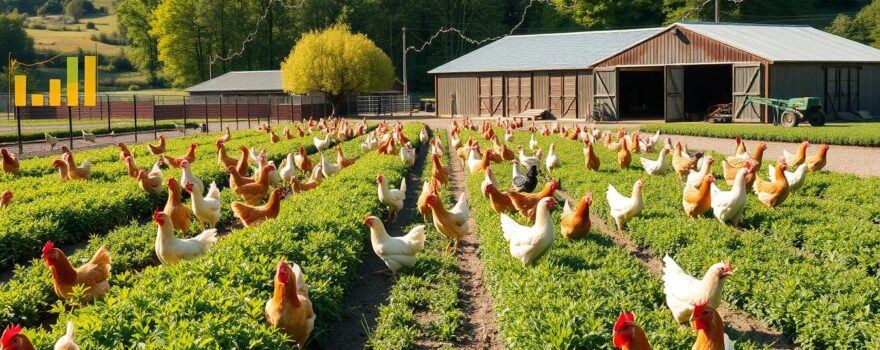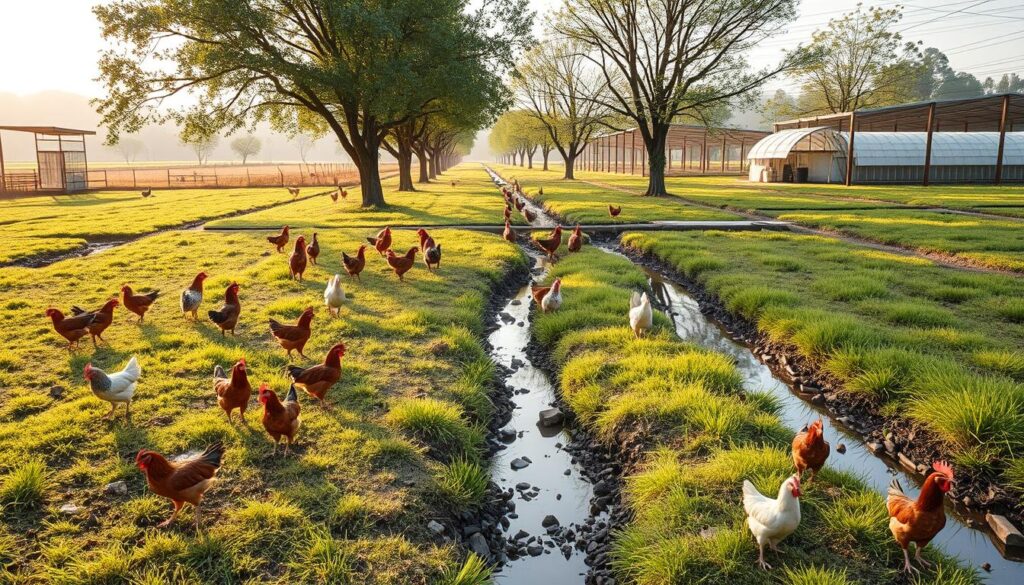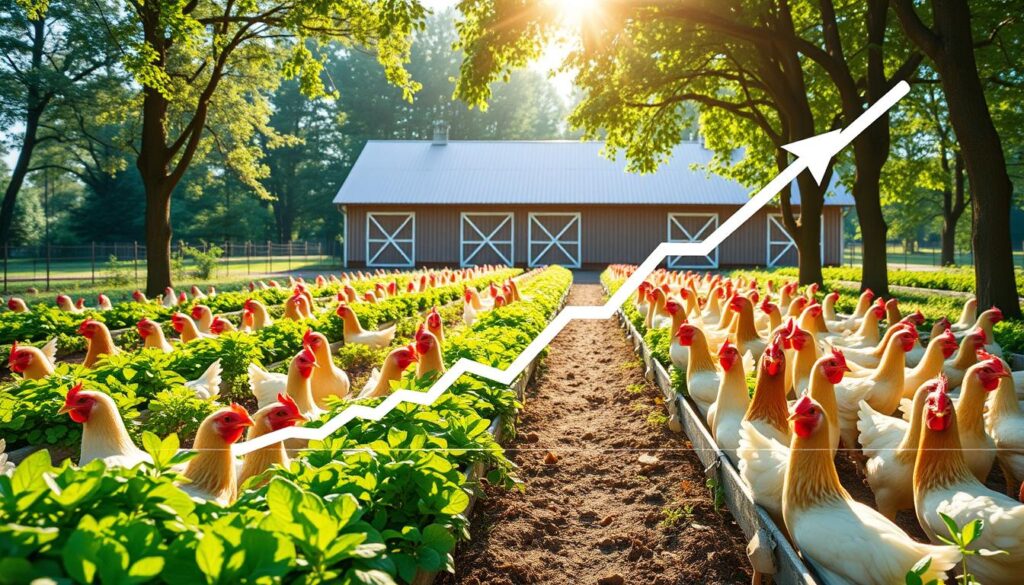
The need for ethical and sustainable food is on the rise. This has made the economics of high welfare standards in broiler farming very important. We look at how better animal care affects costs, consumer choices, and the whole poultry industry.
Key Takeaways
- Understanding the economic implications of implementing high welfare standards in broiler farming, including the impact on farming costs and profitability.
- Examining the growing consumer demand for ethical meat production and the willingness to pay for welfare-friendly products.
- Exploring the environmental and economic benefits of sustainable agriculture practices in broiler farming.
- Analyzing the role of animal welfare regulations and compliance in the poultry industry.
- Assessing the broader economic impact of the broiler industry and its ability to adapt to changing market demands.
The Economics of Implementing High Welfare Standards in Broiler Farming
Switching to better welfare in broiler farming can change a farm’s finances. It means spending more on better living spaces, fun activities, and natural light. This can make farming less profitable but also opens up new chances.
Upgrading farms to better standards costs money. You need to spend on new homes for birds, better food and water systems, and more staff. It’s important to think about if it’s worth it in the long run.
But, there’s a silver lining. More people want ethical meat production. Farms that offer better conditions can charge more. This can help farmers make more money and stand out in the market.
Also, farming better can save money and help the planet. It uses less energy, is more efficient, and keeps soil healthy. These benefits can save money over time and make farming more sustainable.
Deciding to improve welfare in broiler farming needs careful thought. Farmers must look at the costs and benefits. They need to see how it affects their profits and if it meets animal welfare regulations and ethical meat production demands.
Broiler Chicken Welfare: A Growing Concern
The welfare of broiler chickens is a big issue for both consumers and the agriculture world. More people are now aware of animal welfare and want meat produced ethically and sustainably. This means focusing on the animals’ wellbeing.
Defining High Welfare Standards
High welfare standards in broiler farming include many things. Chickens need enough space, natural light, clean water, and good food. They should also be able to behave naturally, like foraging and dust bathing.
It’s also important to ensure humane slaughter and avoid practices that hurt or stress the chickens. This includes not trimming their beaks and slowing down their growth.
Consumer Demand for Ethical Meat Production
More and more people want meat from farms that care about animal welfare. Over 80% of Americans are willing to pay more for meat from animals raised under high welfare conditions. This change in what people want has made the broiler industry look into better ways to produce meat.
The push for better welfare in broiler farming comes from consumers and the need for sustainable farming. Sustainable farming is good for animals, the environment, and the industry’s future. As the industry changes, the welfare of broiler chickens will become even more important.
Impact on Poultry Farming Costs
High welfare standards in broiler farming can change costs a lot. Farmers need to invest and change how they work to meet animal welfare rules and consumer demand. These changes can affect how profitable a farm is and the whole broiler industry.
One big cost is updating infrastructure. Farmers might need to make their places bigger and better for chickens. This could include adding perches, dust baths, and natural light. These upgrades cost a lot of money at first.
Also, moving to sustainable farming can increase costs. This might mean using organic feed or renewable energy. Farmers might also spend more on training staff and watching animals to follow welfare rules.
The costs don’t stop with the first investments and changes. Farmers might pay more for labor because of the need for more hands-on care. They might also see lower production or slower growth because of the welfare-friendly practices. This can make the farm less profitable.
To figure out the impact on farm profits, farmers and experts need to look at the costs and benefits. They should think about the long-term health of animals and lower death rates. They should also consider higher demand and prices for ethical meat production.
“Transitioning to high welfare standards in broiler farming requires a comprehensive evaluation of the economic implications. Farmers must balance the upfront investments and ongoing operational costs with the potential for increased consumer demand and improved long-term sustainability.”
Understanding the costs of high welfare standards helps farmers and the industry make better choices. They can choose to follow sustainable agriculture practices and animal welfare regulations in a way that’s good for the long run. This can help the broiler farming industry stay strong and profitable.
Sustainable Agriculture Practices in Broiler Farming
The broiler farming industry is changing to meet the demand for ethical and green meat. It’s focusing on better animal care and less harm to the environment. These new methods help the chickens and also bring good news for the planet and the farm’s.
Environmental and Economic Benefits
Broiler farms are using less resources, which saves money and makes them more efficient. For instance, slower-growing chickens need less food and water, which is better for the planet. Also, letting chickens outside helps them behave naturally and improves their life, saving on expensive buildings.
- Less feed and water means lower costs
- Healthier chickens from better living conditions
- Less harm to the environment, like less pollution and waste
These green practices are good for the earth and can make farms more profitable. By offering ethical meat production, farms can sell their products for more, boosting their bottom line.
“Sustainable agriculture practices in broiler farming can unlock a win-win scenario, where animal welfare, environmental conservation, and farm profitability all converge.”
The broiler industry is evolving to meet new animal care rules and what consumers want. By adopting these green methods, farms can thrive in the long run and help the broader sustainable agriculture movement.

Animal Welfare Regulations and Compliance
As more people want ethical meat, broiler farmers face a tough set of rules. These rules, made by governments and groups, help ensure chickens are treated well. Following these rules can be costly and affect how farms run.
Broiler farmers must meet certain standards. This includes giving chickens enough space and light. They also can’t use certain practices that hurt the birds. Farmers need to show they let chickens behave naturally, like dust bathing.
- Minimum space requirements for broiler chickens, often measured in square feet per bird
- Regulations on lighting, ventilation, and other environmental factors to promote natural behaviors
- Restrictions on practices that may cause pain or distress, such as beak trimming
- Mandates for access to enrichment materials and opportunities for exercise
Following these rules costs a lot. Farmers need to invest in new things and keep an eye on how things are going. They have to weigh the cost of caring for animals against making a profit.
“Sustainable agriculture practices and ethical meat production are no longer just consumer preferences – they are becoming integral to the long-term viability of the broiler industry.”
To stay ahead, farmers need to keep up with new rules and ways of doing things. This is key for those who want to sell products that are good for animals and people.
Farm Profitability Analysis
The broiler industry faces a big challenge as demand for ethical meat grows. It’s key to understand how high welfare standards affect the bottom line. A detailed farm profitability analysis can show if adopting sustainable practices is worth it.
Cost-Benefit Analysis of Welfare Standards
Doing a thorough cost-benefit analysis is vital. It looks at the extra costs of better animal care, like new facilities and more labor. But it also sees the benefits from selling meat that’s better for animals and the environment.
Here are some points to consider:
- Costs of upgrading and new farming methods
- More money for feed, vet care, and labor
- More money from selling meat that’s better for animals
- Long-term benefits like healthier animals and a better brand image
By looking at both sides, farmers can decide if higher welfare standards are good for business. This way, they can find the best balance between making money and doing the right thing for animals and the planet.
| Key Factors | Estimated Costs | Potential Benefits |
|---|---|---|
| Infrastructure Upgrades | $500,000 – $1,000,000 | Improved herd health, reduced veterinary costs |
| Operational Expenses | 5-10% increase in labor, feed, and other costs | Premium pricing for welfare-certified products |
| Environmental Impact | Modest increase in energy and water usage | Reduced waste, improved sustainability, enhanced brand reputation |
The cost-benefit analysis is a powerful tool for farmers. It helps them understand the financial side of choosing to raise animals better. This way, they can make choices that are good for their business and for the animals.

Consumer Willingness to Pay for Welfare-Friendly Products
The demand for ethical meat and sustainable farming is rising. This puts pressure on the broiler industry to meet these new standards. A study from Kenya looks into how much people are willing to pay for chicken raised with care.
In Nairobi, people like chicken raised humanely and transported safely. But, they don’t want chicken treated with antibiotics. This shows a clear trend: consumers want their chicken to be ethically sourced and antibiotic-free.
This trend is both a challenge and an opportunity for the broiler industry. Higher welfare standards might raise costs, affecting profit margins. Yet, the chance to sell more premium products could make up for these expenses.
| Attribute | Consumer Willingness to Pay (Premium) |
|---|---|
| Humane Treatment | Positive |
| Certified Transportation | Positive |
| Antibiotic Use | Negative |
The broiler industry must understand the economic side of adopting better welfare standards. It’s important for policymakers and industry leaders to work together. They need to create rules that support both ethical farming and the industry’s financial health.
“Consumers are increasingly willing to pay a premium for broiler products that are produced under high welfare standards, creating both challenges and opportunities for the industry.”
Broiler Industry Economic Impact
The demand for ethical and sustainable meat is growing. The broiler industry must change to meet these new needs. This change requires producers to rethink their ways and invest in better practices.
Adapting to Changing Market Demands
Poultry producers face a tough balance. They need to stay profitable while meeting animal welfare demands. This means improving living conditions and using new technologies.
These changes affect many areas, like costs and how products are sold. Producers who focus on animal welfare can attract more customers. This could lead to higher profits.